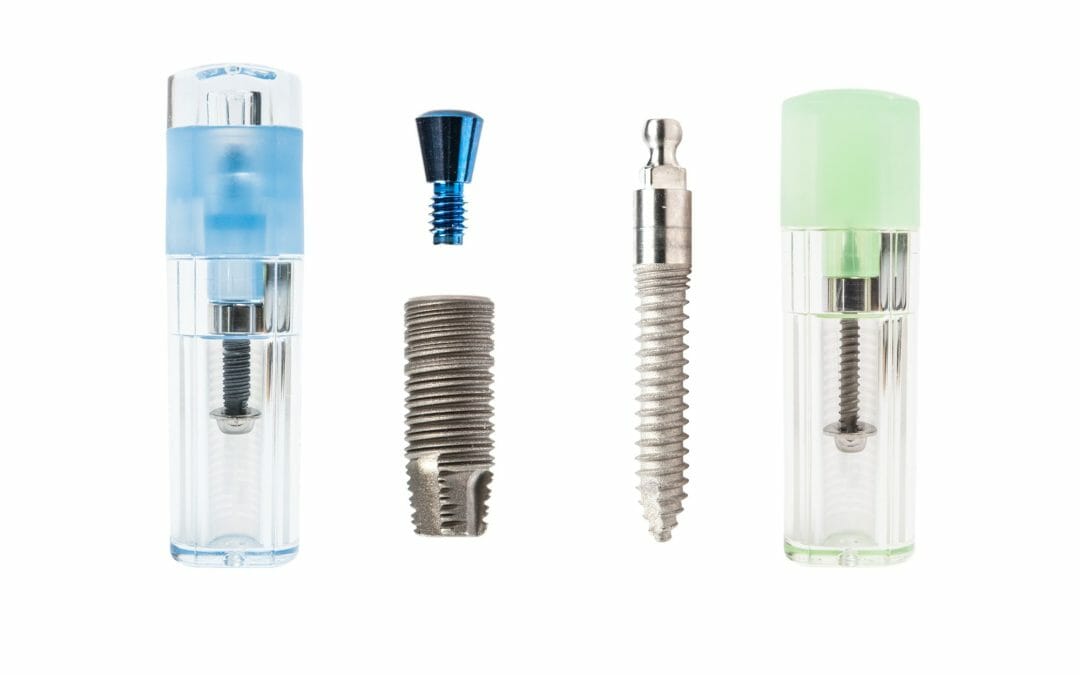Dental implants are one of the most popular treatment choices for replacing missing teeth because they offer versatility in treatment choices along with a variety of unparalleled benefits in smile restoration. Dental implants can be used to replace one or several of a patient’s missing teeth, and they also are, by far, the most natural-looking, feeling, and functioning tooth-replacement option available. Dental implants can even mimic a tooth’s natural root system to keep a patient’s jawbone strong and healthy.
If you are missing one or more teeth and want to restore your smile’s form and function, then one of the following types of dental implants might be the right choice for you.
What Are the Different Types of Dental Implants?
There are three basic types of dental implants:
Endosteal Dental Implants
An endosteal dental implant is the most frequently used type of dental implant, and it’s what most people think of when they think of dental implants. The endosteal dental implant is a screw-like dental prosthetic that is designed to be implanted directly in a patient’s jawbone. The implant then osseointegrates and fuses with the jawbone throughout a healing period before being attached to an abutment and later a permanent tooth replacement.
This type of dental implant stimulates the patient’s jawbone, keeping it healthy. However, it does require that a patient has enough jawbone mass available for implantation. If enough mass is not present, the patient can either undergo a bone grafting procedure to prepare the jawbone for an endosteal implant or the patient can consider one of the other two types of dental implants.
Subperiosteal Dental Implants
Although they are not used nearly as frequently, subperiosteal dental implants are the most commonly used alternative to endosteal dental implants. This type of dental implant is not designed to be implanted into the jawbone. Instead, it features a metal, frame-like structure that rests on top of the patient’s jawbone beneath the gum tissues. Instead of the jawbone holding the implant in place, the gum tissues eventually support it as they heal around the frame.
Subperiosteal dental implants are typically only used when a patient does not have enough jawbone mass present to support an endosteal implant and either cannot or does not wish to undergo a bone grafting procedure.
Zygomatic Dental Implants
Of all the types of dental implants, zygomatic dental implants are used the least frequently. A zygomatic dental implant is implanted in a patient’s cheekbone, rather than the jawbone.
These implants require a much more complex and invasive procedure for placement, and they are only used when a patient does not have adequate jawbone mass to support the previous two types of dental implants.
Choices in Dental Implant Materials
Dental implants are available in two different materials:
Titanium
Most dental implants are made of titanium. This is a biocompatible metal that is very strong and resilient. Dental implants made of titanium can withstand great force and are designed to last a patient a lifetime with proper oral care.
Zirconia
Zirconia is a fairly new type of material for manufacturing dental implants. It has only recently been approved by the FDA for use in dental treatments, but it does provide a great alternative for individuals who have allergies or sensitivities to metals.
Zirconia is ceramometal, a fusion of metal and ceramic, that can be used to create hypoallergenic dental implants. While zirconia is tough, it’s not quite as strong as pure titanium.
Dental Restorations Supported by Dental Implants
Dental implants can be used to support a variety of tooth-replacement options (i.e. the visible “tooth” or “teeth” that one or more dental implants support).
Single Tooth or One-for-One Replacement
The abutment fixed to a dental implant can be topped with a permanent crown to replace a patient’s missing teeth on a one-for-one basis. So, if a patient is missing one tooth, then they’ll need one crown-topped dental implant. If they are missing two or three, then they would need two or three crown-topped dental implants.
Implant-Supported Dental Bridge
Dental implants can also be used to support prosthetic devices called dental bridges. These devices are used to replace multiple teeth that are missing in a row. Traditionally, dental bridges are supported with crowns that cap the teeth neighboring the gap of missing teeth or with wires and dental bonding.
Implant-Supported Dentures
Full or partial dentures can also be supported by dental implants. Usually, four or six strategically placed dental implants can support a denture to replace a full arch of teeth. Implant-supported dentures can be permanently fixed to dental implants or designed to snap off in the dentist’s office for easy maintenance and care.
Which Type of Dental Implant Is Best?
Many regard endosteal dental implants as the best kind because they offer direct stimulation to the jawbone, which means they offer the most treatment benefits to patients.
The type of dental implant, however, that is best for you depends on your individual needs, medical history, current oral health status, and treatment goals.
Smile Restoration Consultations in West Bend, Wisconsin
At Dentistry of West Bend, our dentist, Dr. Jared Harding can help you determine which type of dental implant or other restorative dental treatment is the right one for you. During a smile restoration consultation, Dr. Harding can examine your mouth and talk with you about your treatment goals and expectations, oral health needs, medical history, treatment preferences, and dental care budget to help you determine which type of dental implant or treatment plan is right for you.
To learn more or schedule an appointment, we welcome you to contact Dentistry of West Bend today.


Recent Comments